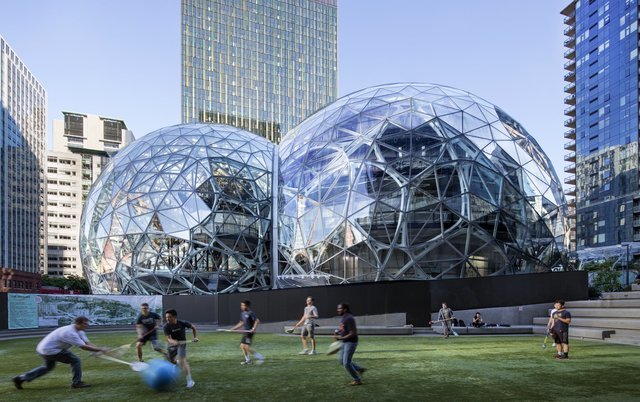
Amazon recently announced that it plans to build a second headquarters (in addition to its existing headquarters in Seattle), and invited cities across the US to compete for the honor of hosting it. Writing for the n+1 website, Nikil Saval suggests that the ensuring clamor—with cities falling over themselves to offer deep tax breaks to the corporate giant—illustrates that the ideology of “urbanism,” which attributes urban prosperity to a magical combination of parks, museums, and gay people, has always be fatuous. Instead, argues Saval, cities remain worryingly dependent on the whims of corporations like Amazon, and the only thing that can alter this status quo is old-fashioned political organizing. Here’s an excerpt from Saval’s piece:
The most serious academic riposte to the urbanist ideology has been Michael Storper’s Keys to the City (2013), which demonstrates comprehensively what one might always have guessed, and what the Amazon contest has proven: the location of businesses, rather than the walkability, density, and diversity of a city, determines its economic health. A statistically insignificant portion of the country will up and move to Dallas because they are fiending for breakfast tacos that they can sort of walk to, near a private-public partnership-funded park that caps a freeway where they can sort of enjoy them. Most people, however, move to a place in search of jobs, not “urbanism.” “Even though London, New York, and Paris have central-city neighborhoods that are consumption playgrounds for the rich of the world,” Storper writes, “they are above all major productive hubs in the global economy. The vast majority of their people come to these cities in order to work. The world urban system—from its richest to poorest cities—is not a set of playgrounds or amenity parks but instead a vast system of interlinked workshops.” That this even needs to be argued suggests the level of delusion that persists about what metropolitan regions actually do, and why people live in them. It is a delusion that has taken hold not only on the lecture circuit and PowerPoint presentations and websites that lend their names to “ideas festivals,” but among ordinary city-dwellers.
Urbanism has helped to obscure how implicated cities are in the broader changes of our time. The city we have today is, like everything, characterized by a spectacular level of inequality. To look at a standard city map is to miss an invisible overlay of policies and business incentives that pit one part of the city against the other, much as Amazon pitted all cities against one another. Private-public partnerships make some parks better than others; tax abatements create high-end residential and commercial construction in the urban core, while the poor in the urban periphery enjoy the indignity of under-regulated “enterprise zones” or having to compete for federal “promise zones”; property values spike in the vicinity of a “good” school and dive in the neighborhood of a “bad” one; closely related are the policies that entice cavalcades of police to one area and not to others, ensuring that the carceral state weighs in some neighborhoods like an unshakable stone. The determining center remains, as it has for generations, and as it will in the age of Amazon, the wide floor plates in the heavily air-conditioned offices of the country’s major corporations, which pay proportionally less in taxes to the city and state where they reside than your average middle-class family. As a substitute for more concerted city planning, urbanism has had little success in encouraging the diversity it claims to seek. As a cover for the true nature of the neoliberal city, it has been a triumph.
Image: Amazon headquarters in Seattle. Via LA Times.